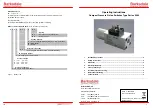
Fixed Status Current Switches
Installation and Operation
#NSA-A/CS2, NSA-A/SCS2, NSA-A/SCS2-L
– 11/14/2019
Specifications subject to change without notice.
Catalog No. 11-808-756-01
Page
5
of
7
Wires Through Sensors
Figure 4
APPLICATION NOTES
The conductor being monitored may be looped through the sensor multiple times. The loops increase the current
measured by the current switch. Each time the conductor passes through the current switch window equals one loop
(Figure 4). To determine the proper number of loops required, take the rated Fixed Trip Point of the current switch and
divide it by the Operating Current of the Monitored Device, add one (1), then round up to the nearest whole number.
Example: When using the NSA-A/CS2, a small fan operating at 0.1A should be wrapped through the sensor four times to
give you a total operating current of 0.4 Amps flowing through the NSA-A/CS2. Formula Example: (0.25A/0.1A) = 2.5 + 1 =
3.5, which rounded up equals 4 loops
.
Wiring Instructions
Carrier recommends the use of a two conductor 16 to 22 AWG shielded cable or twisted pair copper wire only, for all
current switch applications. A maximum wire length of less than 30 meters (98.4 feet) should be used between the current
switch and the Building Management System or controller. Note: When using a shielded cable, be sure to connect only (1)
end of the shield to ground at the controller. Connecting both ends of the shield to ground may cause a ground loop. When
removing the shield from the sensor end, make sure to properly trim the shield to prevent any chance of shorting. The
current switch output terminals represent a solid-state switch for controlling both AC and DC loads and are not polarity
sensitive. Tighten the screws at the terminal block connections to the recommended torque of 0.5 to 0.6 Nm (4.43 to 5.31
in-lbs). The aperture (hole) size of the current swit
ch is 0.75” (1.90 cm).

























